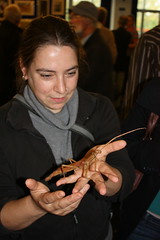Notes from my experience breeding and studying a wide variety of different invertebrates.
Monday 30 November 2009
Sunday 29 November 2009
Peacock Spider

It can raise a pair of legs and fan out two brightly patterned flaps at the back of its body.
Displaying its spectrum of shades in an attempt to attract the attention of the less vibrant brown spiders, the creature reveals hues of orange, yellow, green and blue.
Also known as a Maratus Vilans, amateur photographer Jurgen Otto originally spotted the colourful creature in the wild.
However, as it is only 4mm long, he found it easier to capture images in his Sydney home.
The spider also uses its third pair of legs in the mating display, raising them to show a brush of black hairs and white tips.
The spider can also jump, but the common belief that it can use its patterned flaps to glide through the air is an urban myth which has been debunked by the Australasian Arachnological Society.
The spider is found in eastern parts of Australia, including Queensland and New South Wales.
Both sexes of the spider rarely reach more than 5mm in body length. Females are brown with no distinct pattern."
Presents for Entomologists
Monday 23 November 2009
Leaf cutter ants and bacteria
Sunday 22 November 2009
Poecilimon sp.: Orthoptera from Turkey
Spider Smuggling
Saturday 21 November 2009
Invertebrate Rearing journal
Saturday 7 November 2009
Wildlife Photographer of the Year 2009
 On the 27th October 2009 (yet another timely post) I visited the Wildlife Photographer of the Year preview at the Natural History Museum, London. This year the exhibit has moved to a different gallery, giving it a bit more breathing room and has a more modern feel with blue lighting - it all looks very impressive.
On the 27th October 2009 (yet another timely post) I visited the Wildlife Photographer of the Year preview at the Natural History Museum, London. This year the exhibit has moved to a different gallery, giving it a bit more breathing room and has a more modern feel with blue lighting - it all looks very impressive.

Mating Barnacles Video
Mating barnacles from Casey Dunn on Vimeo.
For more information about barnacle mating check out Mating when you are stuck to a rock by Creature Cast.
Have you got a good marine invertebrate blog post?
Tuesday 3 November 2009
The AES Exhibition
Every year the Amateur Entomologists' Society has an exhibition where you can buy all kinds of live and dead insects, and all the equipment that goes with having an interest in either or both.
As usual I was tied up with helping the Phasmid Study Group and Blattodea Culture Group for a lot of the time (which is fun but doesn't always leave time to have a good look around the rest). One of the people who stopped by to chat was Erica (responsible for the Curator of Diptera's blog). She can be seen here with the phasmid Anchiale maculata.
Somewhat surprisingly I only took two photographs - the Flickr set could just as easily have been called dipterists meeting phasmids really.
ShareThis
Copyright Ed Baker


